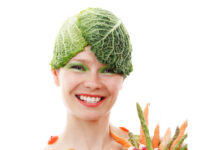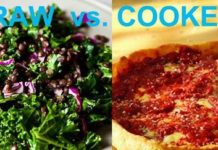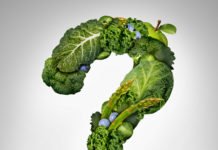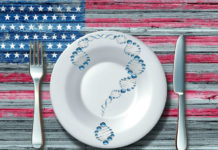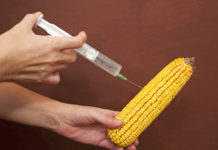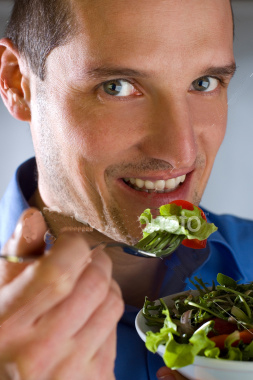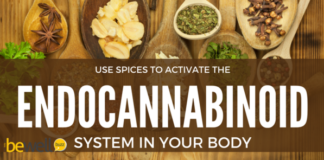An increasing number of athletes are adopting vegetarian and vegan diets for ecological, economic, religious, health and ethical reasons. Vegetarian diets (except possibly fruitarian and strict macrobiotic diets) can easily meet the nutritional requirements of all types of athletes provided they contain a variety of plant-foods. Vegetarian athletes, like most athletes, may benefit from education on food choices that benefit athletic performance and promote overall health.
Energy and Macronutrient Requirements.
Energy. Energy needs of active vegetarians vary considerably and depend on the athlete’s body size, body composition, gender, training regimen and activity pattern. As reviewed by Goran (1), energy expenditure was found to vary from about 2600 kcal/d in female swimmers to about 8,500 kcal/d in male cyclists participating in the Tour de France bicycle race. In clinical practice, assessing daily energy expenditure (DEE) of athletes may be difficult. Thompson and Manore (2) recently reported that resting metabolic rate (RMR) of endurance-trained athletes can be accurately estimated using the Cunningham equation which is based on fat-free mass rather than body mass. According to some studies, RMR is acutely elevated after exercise (3) and is about 11% higher in vegetarians compared to nonvegetarians (4) which is difficult to account for in prediction equations. Accurately estimating nonresting energy expenditure is extremely difficult due to individual variations in energy expenditure during both exercise/training and daily physical activity (1, 3). As discussed by Goran (1), non-exercising physical activity level should be carefully considered since it is known to decrease in some athletes during heavy training.
Estimating DEE may be useful when developing meal plans, evaluating adequacy of energy intake (along with body weight changes and dietary intake assessments) and educating athletes on energy needs. Estimates of DEE, however, are not always necessary and may be associated with considerable error. DEE can be estimated by first calculating RMR, applying the appropriate activity factor (1.3 for light ,1.5 for moderate or 1.7 for heavy activity) and adding an estimate of average weekly training regimen using an activity chart (found in many exercise physiology and nutrition texts). Vegetarians, especially vegans, reportedly have lower energy intakes and more difficulty meeting energy requirements than nonvegetarians due to the low caloric density of their diets (5). Nutritionists, however, are likely to encounter vegetarian athletes with a variety of energy needs. Some will need to consume 6-8 meals/snacks per day to meet energy needs. Others may require weight loss for health and/or performance reasons. Eating plans, such as those developed by Houtkooper (6) and Messina and Messina (7), are helpful for educating vegetarian and vegan athletes.
Carbohydrates. Carbohydrates should make up the largest portion of the athletes diet. Numerous studies have concluded that increased carbohydrate (CHO) intake can improve exercise capacity and that low-CHO diets can be detrimental to performance. High-CHO diets optimize muscle and liver glycogen stores (8,9) and have been shown to optimize performance during prolonged, moderate intensity exercise (i.e., distance cycling and running (10-13), and during intermittent (14) and short duration, high-intensity exercise (15-18). Recent studies have also suggested that benefit of CHO consumption is not limited to maintenance of glycogen stores, but also related to maintenance of Krebs cycle intermediates (12) and preservation of the bioenergetic state of exercising muscle (17) (factors also related to muscle fatigue).
Sports nutrition guidelines recommend that 60-65% of total energy should come from CHO (19). It may be more appropriate, however, to base recommendations on body weight which is independent of energy intake (20). Nutritionists should educate vegetarian athletes on good sources of CHO and provide guidelines for meeting daily intake of 7-10 g/kg. Usually athletes understand this type of approach, especially when CHO exchanges are used.
Protein. Protein needs of athletes vary according to type of activity and level of training. The American and Canadian Dietetic Associations recommend that athletes consume 1.5 g of protein/kg of body weight (19). Two recent reviews, however, have come to very different conclusions regarding protein requirements of physically active individuals (21, 22). Millard et al (21) states that there is no consensus as to whether protein requirements are influenced by physical activity. Lemon (22), on the other hand, suggests that protein requirements are approximately 1.2 to 1.4 g/kg/d for endurance athletes and, approximately 1.4 to 1.8 g/kg/d and for strength athletes. These values for strength athletes, however, are higher than those of elite body builders (1 g/kg/d) and may actually reflect requirements during early stages of resistance training (23). The rationale for the additional required protein in endurance and strength training results from increased protein utilization as an auxiliary fuel during exercise and to a lesser degree protein deposition during muscle development (22). Inadequate intakes of CHO (24) and energy (25) have also been found to increase protein needs. During prolonged endurance activity, athletes with low glycogen stores metabolize twice as much protein as those with adequate stores primarily due to increased gluconeogenesis (24). As a final note, protein requirements in most published studies have been evaluated in young men, and may be different in females and/or older athletes. Recent studies have found that females, relative to males, catabolize less protein consequent to endurance exercise (26), and that older sedentary men require protein in excess of the RDA (27). Clearly, more research is needed in this area.
Despite the controversy over protein requirements, vegetarians athletes can easily achieve adequate protein providing their diet is adequate in energy and contains a variety of plant-protein foods such as legumes, grains, nuts and seeds. Vegetarians need not be concerned with eating “complementary proteins” at each meal but rather over the course of a day (28). Vegetarian diets contain on average 12.5% of energy from protein while vegan diets contain 11% (7). A 80 kg male athlete consuming 3600 calories would receive 1.41 g/kg of protein from the average vegetarian diet and 1.2 g/kg of protein from the average vegan diet. A 50 kg female gymnast consuming 2200 kcal/d would receive 1.38 g/kg from a vegetarian diet and 1.21 g/kg from a vegan diet. Therefore, most vegetarian athletes meet the requirements for endurance training without special meal planning. Strength trained athletes (weight lifters, wrestlers, football players or field throwers), or those with high training levels or low energy intakes may need to include more protein-rich foods. This is easily accomplished by encouraging the athlete to add 1 to 3 servings of protein-rich foods to their current diet (e.g., soy milk shake, lentils onto spaghetti sauce, tofu added to stir-fry or garbanzo beans to salad).
Fat. Dietary fat should make up the remainder of energy intake after CHO and protein needs are met. The American and Canadian Dietetic Associations recommend that <30 % of total energy intake should come from fat (19). Recently, several studies stirred some controversy, particularly in the lay public, with the suggestion that highly-trained athletes may perform better on “high-fat” diets (29,30). When compared to previous studies showing beneficial effects of high-CHO, low-fat diets (8,10-12,15-18), these studies (29,30) assigned a longer dietary manipulation period (1-2 weeks vs. 1-3 days) and had the subjects continue heavy training during the manipulation period. While this fat loading research seems to contradict previous work, it is worth noting that the studies have some methodological flaws (i.e., one was not randomized, both used only 5-6 subjects, both did not see consistent metabolic responses to support the concept that the high-fat diet produced the improvement) (31). On the other hand, these studies may suggest that diets chronically too low in fat ( 15%) are not best during heavy training. In both studies, the high-CHO diet contained only 12-15% energy from fat compared to the high-fat diet that was 38% in one study (30) and 70% in the other (29). Muoio, et al (30) speculated that a certain amount of fat may be required to maintain intramuscular triglyceride stores which may serve as an important fuel during heavy exercise (32). Certainly further research is warranted.
Some athletes, particularly endurance-trained groups (runners and triathletes), may go overboard with the desire to consume a high-CHO diet and consume too little fat. Similarly, while extremely low-fat (<10%) vegetarian diets recommended by Ornish et al (33) may be beneficial to those with a personal or family history of cardiovascular disease (i.e., the post-MI recreational runner), they may be too restrictive for athletes during heavy training. Higher intakes of fat — particularly from mono- and polyunsaturated sources– may actually be beneficial, providing CHO and protein needs are met. Incorporating more high-fat foods such as nuts and seeds, nut butters, tahini, avocados, olives, olive oil, sesame oil, etc. may make it easier for heavily trained vegetarian athlete to meet energy and nutrient needs and ensure that intramuscular triglycerides are not compromised (34). On the other hand, nutritionists can still expect to encounter vegetarian athletes with diets that are lacking in CHO and too rich in saturated fat mainly from full-fat dairy products.
Minerals, Vitamins and Supplements
Calcium. Calcium recommendations for active men and pre-menopausal women are not different than the RDA which is 800 mg for adults. Studies from Heaney’s laboratory report that calcium intake of 1500 mg/d is needed to retain calcium balance in women with low circulating estrogens (35). Thus higher calcium intakes may be required for amenorrheic as well as postmenopausal athletes. Calcium intake, however, is one of many factors associated with calcium balance, and accounts for only ~11% of its variation (36). Urinary calcium excretion, on the other hand, accounts for ~51% of the variation in calcium balance and is influenced by dietary protein, sodium and possibly phosphoric acid intakes. There is evidence to suggest that vegans (and possibly vegetarians who consume little dairy products) may have lower calcium requirements due to their lower intakes of animal protein, total protein and sodium which increase renal calcium excretion (7). However, until more is known about calcium requirements in this group, it is prudent that all athletes meet the RDA for calcium. Low calcium intake has been associated with an increased risk of stress fractures (37) and low bone density particularly in amenorrheic females athletes (38).
Eumenorrheic athletes can meet calcium requirements by including several servings of dairy products and/or calcium-containing plant foods daily. Calcium-rich plant foods include kale, collard and mustard greens, broccoli, bok choy, legumes, calcium-set tofu, fortified soymilk, TVP, tahini, calcium-fortified orange juice, almonds, and blackstrap molasses. Depending on their energy intake and food choices, female vegan athletes may need to use fortified foods or calcium supplements to meet their calcium requirements, particularly if amenorrhea is evident. Well absorbed calcium supplements such as calcium carbonate are appropriate when the athlete does not have access to, or cannot afford calcium-fortified foods.
Iron. All athletes, particularly female endurance athletes are at risk of iron depletion and iron deficiency anemia. Iron loss is increased in some athletes, particularly heavily-training endurance athletes, due to gastrointestinal bleeding (39), heavy sweating (40), and hemolysis (41,42). Insufficient iron intake or reduced absorption, however, are the most probable causes of poor iron status. Snyder (43) found that female vegetarian runners had a similar iron intake but lower iron status than nonvegetarian runners. Most of the iron in a vegetarian diet is non-heme iron which has a relatively low absorption rate (2-20%) compared with heme iron (15-35%) (44). This may be of significance since low iron stores even without anemia have been associated with decreased endurance (45).
In most cases, vegetarian athletes can achieve proper iron status without iron supplementation. However, they need to be educated on plant sources of iron and factors that enhance and interfere with non-heme iron absorption. For example, an athlete who consumes milk or tea with beans at lunch could be advised to replace this beverage with citrus fruit juice to enhance iron absorption at that meal (44). In some cases, vegetarian athletes may temporarily require supplements to build up or maintain iron stores. Athletes taking iron supplements should have iron status monitored due to the potential association between iron status and chronic disease (46).
Zinc.Several studies have reported altered zinc status in heavily-training athletes which is of particular concern when coupled with reportedly low zinc intakes in some athletes (47). Manore, however, has cautioned that apparent changes in zinc status due to exercise may be transient, and measurements of plasma zinc during heavy training periods may not reflect zinc status (48). Although little is known regarding the zinc status of vegetarian athletes, one should have some concern since the absorption of zinc from plant foods is somewhat lower than from animal products due to higher phytate concentrations of plant foods (49). Vegetarian sources of zinc include legumes, hard cheeses, whole grain products, wheat germ, fortified cereals, nuts, tofu, and miso. Although more research is needed in this area, published studies have found that zinc supplementation does not influence zinc levels during training (48,50) and has no apparent benefit on athletic performance (50).
B vitamins. Vegetarian diets can provide the requirements for most B vitamins. Depending on the type of vegetarian diet, however, riboflavin and vitamin B12 are potential exceptions. Several studies have suggested that riboflavin needs may be increased in individuals with marginal riboflavin status who begin an exercise program (51, 52). Since riboflavin intakes are reportedly low in some vegans (5), active vegetarians who avoid dairy products should be educated on plant sources of riboflavin to ensure adequate intake. Plant sources of riboflavin include whole grain cereal, soybeans, dark green leafy vegetables, avocado, nuts and sea vegetables.
Vitamin B12 has been of interest to athletic performance possibly due to its function in maintaining the cells of the hemopoietic and nervous systems. In fact, injections of B12 are still used by some athletes/coaches because of the belief that oxygen delivery is increased which in turn will enhance endurance. However, in the absence of actual deficiency, studies have failed to demonstrate any benefit of this practice (53) or of high-dose supplementation with a multivitamin (54). Since cobalamin, the active form of B12, is found exclusively in animal products, vegan athletes need to regularly consume B12 fortified foods which include Redstar brand (T6635) nutritional yeast, and those brands of soymilk, breakfast cereals and meat analogs that are B12 fortified. Vegetarians who consume eggs, cheese, milk or yogurt receive an ample supply of this vitamin.
Antioxidant Vitamins. Increasing evidence suggests that vitamins C and E and -carotene may protect against exercise-induced “oxidative stress”. Several recent reviews have summarized the current understanding of the potential benefits of antioxidant supplements in protecting against free radical production and lipid peroxidation (55,56) In brief, supplementation with antioxidants appears to reduce lipid peroxidation but has not been shown to enhance exercise performance (56). Whereas regular training is also found to augment endogenous antioxidant systems, athletes who train sporadically, i.e. “weekend athletes”, may particularly benefit from dietary antioxidants since it is not known if these athletes have the augmentation produced through continued training. While it remains controversial whether athletes or recreational exercisers should take antioxidant supplements, there is no doubt that athletes should ingest foods rich in antioxidants (56). Vegetarian athletes may have an advantage since antioxidants are readily obtained from a diet rich in vegetables, nuts, seeds, and vegetable oils.
Creatine.Creatine monohydrate is a “hot” supplement that is showing some potential and may be of particular interest to vegetarian athletes. Double blind, placebo controlled studies have shown that creatine supplementation of 15-20 g/d for 5 days increases muscle concentrations of creatine by about 20% (57) and improves performance during repeated bouts of high-intensity (58-62) but not endurance (63) activity. In practice, nutrition supplement companies recommend an initial loading phase for 3-7 days, followed by a maintenance dose of about 5 g/d. Supplement companies also claim creatine is not synthesized using animal derivatives.
Most of the creatine found in the body is in skeletal muscle where it exists mostly as creatine phosphate (64), an important storage form of energy that buffers ATP and thus serves to maintain the bioenergetic state of exercising muscle. The average dietary intake is about 2 g/d in omnivores (64) and negligible amounts in vegetarians since it is found primarily in muscle tissue. Even though creatine can be synthesized extra muscularly from amino acid precursors (64), serum (65) and skeletal muscle (57) creatine concentrations have been found to be lower in vegetarians compared to nonvegetarians. Thus there is some thought that vegetarian athletes in particular may benefit from creatine supplementation. Currently, however, little is known about long-term effects or training benefits of creatine supplementation (64). Most studies have found that supplementation is associated with a rapid 1 kg weight gain that is likely water retention (64). Even this small weight gain, albeit water, could be detrimental to performance in some sports (63). In strength sports, however, increased body mass may be desired. One study has suggested that creatine supplementation may promote greater strength and lean mass gain in response to strength training, although this increase in lean mass was not statistically significant (62). In the authors practice over the past year increasing numbers of recreational and competitive athletes and coaches have shown interest in creatine supplementation. With adults one can review current the scientific data and the expense of supplementation, (as well as the benefits of eating a good diet) and let the athlete/coach make their own decision. With children and adolescents, a prudent approach would be to discourage supplementation.
In addition to creatine, athletes are likely to inquire about a number of other supplements and ergogenic aids. While only caffeine (66) and bicarbonate (67) currently appear to have potential, other aids include citrate, phosphate (67), branched-chain amino acids (68), carnitine, choline (55), chromium (69) and DHEA (70). A discussion of these is beyond the scope of this article.
Nutrition Before, During and After Exercise
Pre-Event Meal. Nutritional intake in the meal before a competition or exercise session should increase fuel stores, provide adequate hydration and prevent both hunger and gastrointestinal distress. Studies have shown that consumption of between 1 and 5 g of CHO/kg BW one to four hours before endurance exercise has the potential to improve endurance performance by as much as 14% (20) and is also thought to benefit high-intensity performance. Vegetarian athletes should be encouraged to consume familiar, well tolerated, high-CHO meals that are low in sodium, simple sugars and fiber. Studies looking at CHO supplementation during the 30-60 min prior to exercise, however, have indicated that CHO may need to be avoided during this period (13,71). To avoid the possibility of rebound hypoglycemia and decreased performance seen in some athletes. Interestingly, recent studies have suggested that consumption of CHO (1 g/kg) with a low glycemic index (lentils vs. glucose or potatoes)1 hour before exercise may prolong endurance during strenuous exercise by maintaining higher blood glucose concentrations towards the end of exercise (71,72), and may also confer an advantage by providing a slow-release source of glucose without an accompanying insulin surge (71). On the other hand, ingestion of a liquid CHO supplement immediately before exercise ( 5 min) is appropriate and has been found to improve performance during endurance (13) and resistance exercise (73).
Specific pre-event food choices, however, may need to be individualized. Athletes sensitive to gastroesophageal reflux should avoid caffeine, chocolate, sulfur-containing vegetables and concentrated sources of fat. Those experiencing frequent nausea, cramps and vomiting should pay attention to meal timing and not eat within 3 or 4 hours before exercise (74). Those experiencing diarrhea often benefit from a low residue diet 24-36 hours before a major event (74). Also, liquid meals are more easily digested and may be helpful for avoiding the pre-game nausea sometimes associated with solid foods (75). Guidelines for fluid consumption include consuming at least 2 cups fluid about 2 hours before exercise, followed by another 2 cups approximately 15-20 min before endurance exercise (19).
Supplementation During Exercise. Carbohydrate ingestion at levels between 45 and 75 g/h have been shown to benefit prolonged, moderate intensity exercise ( 2 h) and variable intensity exercise of shorter duration (11) presumably by maintaining blood glucose levels as endogenous glycogen stores become depleted. Ingestion of fluid replacement beverages easily provide CHO requirements while simultaneously meeting fluid needs. For example, consumption of 4-8 oz of 7% CHO drink (level of most commercial beverages) every 15 minutes (19), would supply 34-50 g CHO/h. Even more CHO can be provided when fluid is ingested in accordance with ACSM recommendations (76).While commercial sports drinks work well, vegetarian athletes may prefer diluted fruit juice (4 oz juice in 4 oz water = 6% solution) or low sodium vegetable juices such as carrot juice (7% solution). Solid CHO supplements are found to work equally as well providing they are ingested with water (77). Foods that are well absorbed and easily-carried include bananas, grapes, orange section, baked potatoes, bagels and sport bars.
Post-Exercise Nutrition. Glycogen and fluid replacement are the immediate concern after prolonged or strenuous exercise. This is particularly important during heavy training. To facilitate rapid muscle glycogen synthesis, research has found that athletes should consume CHO immediately after and at frequent intervals following exercise (78). According to Sherman (78), the rate of CHO consumption should be approximately 1.5 g CHO/kg BW at 2 hour intervals for up to 4 hours. Hence, an 80 kg runner should consume about 120 g at 0, 2 and 4 hours post-exercise. Other glycogen replenishing regimens have also been suggested (6, 19) Two recent studies have suggested that ingestion of foods with a high glycemic index (79) and protein (~1 g protein:3 g CHO) may increase the rate of muscle glycogen storage after exercise by stimulating greater insulin secretion. In the latter study, however, it is difficult to tell whether greater insulin secretion resulted from increased protein or increased energy intake. Current recommendations for post-exercise fluid requirements are to consume at least a pint of fluid for every pound of body weight deficit (80). Consuming water with the recovery meal should be sufficient providing the meal contains adequate sodium and potassium. However, if food is not available or desirable, ingested fluid should contain sodium chloride and other electrolytes. When sodium is provided in fluids or foods, the osmotic drive to drink is maintained and urine production is decreased.
Of Special Concern For the Female Athlete
The prevalence of amenorrhea among exercising women is reported to be between 3.4 and 66 % (81) with higher prevalence in runners as opposed to cyclists and swimmers (82). The cause of this secondary hypothalamic amenorrhea is unknown, but may be related to training level, nutritional status, body composition changes, stress, and hormone changes with exercise (81). While some studies have noted higher prevalence of secondary amenorrhea among “vegetarians” (83,84), other have not come to the same conclusions (85). By definition, however, “vegetarians” in these studies consumed low-meat and not necessarily vegetarian diets. In nonathletic females, Goldin et al (86) found lower circulating estrogen levels in vegetarians compared to nonvegetarians which were associated with higher fiber and lower fat intakes, higher fecal outputs and 2-3 times more estrogens in feces. This may suggest that nutrient composition of some vegetarian diets may be predisposing to amenorrhea. In athletes, several studies have generally found lower intakes of energy, protein, fat, and zinc, and higher intakes of fiber and vitamin A in amenorrheic compared to eumenorrheic athletes (84,87-89).
Given the high prevalence of amenorrhea among athletic women, nutritionists should take a menstrual cycle history as part of screening procedure and if appropriate refer the athlete for medical evaluation and treatment. Nutritional evaluation and education of vegetarian athletes needs to focus on adequacy of energy, protein, fat, zinc and fiber intakes. If appropriate, eumenorrheic athletes can increase energy intake and decrease fiber by consuming 1/3 to 1/2 of their cereal/grain servings from refined rather than whole grain sources and by replacing some high fiber fruit/vegetable servings with fruit/vegetable juices.
Conclusion
Nutritionists can play an essential role optimizing the health and athletic performance of vegetarian athletes of all ages and abilities. Sports nutritionists who work with vegetarian athletes and their coaches and trainers, however, need to be sensitive to and knowledgeable about vegetarian issues. In this setting, the role of the nutritionist is to work with the athlete to ensure adequate nutritional status given his/her vegetarian beliefs, income and lifestyle. While athletes should be encouraged to eat a wide variety of plant foods, this does not mean convincing the vegetarian athlete that they need poultry, fish or dairy products in the diet. The American Dietetic Association’s position on vegetarian diets states that “vegetarian diets are healthy and nutritionally adequate when appropriately planned” (90).
References
- 1. Goran MI, Poehlman ET, Johnson RK. Energy requirements across the life span: new findings based on measurement of total energy expenditure with doubly labeled water. Nutr Res 1994;15:115-150.
- 2. Thompson J, Manore MM. Predicted and measured resting metabolic rate of male and female endurance athletes. J Am Diet Assoc 1996;96:30-34.
- 3. Poehlman ET, Melby CL, Goran MI. The impact of exercise and diet restriction on daily energy expenditure. Sports Med 1991;11:78-101.
- 4. Toth MJ, Poehlman. Sympathetic nervous system activity and resting metabolic rate in vegetarians. Metabolism 1994;43:621-25.
- 5. Grandjean A. The vegetarian athlete. Phys Sportsmed 1987; 15:191-194.
- 6. Houtkooper L. Food selection for endurance sports. Med Sci Sports Exerc 1992;24:S349-S359.
- 7. Messina M, Messina V. The dietitian’s guide to vegetarian diets, Gaithersburg, Maryland:Aspen Publishers, Inc, 1996
- 8. Bergstrom J, Hermansen L, Hultman E, Saltin B. Diet, muscle glycogen and physical performance. Acta Physiol Scand 1967; 71:140-150.
- 9. Nilsson LH, Hultman E. Liver glycogen in man-the effect of total starvation or a carbohydrate-poor diet followed by carbo-hydrate refeeding. Scand J Clin Lab Invest 1973;32:325-330.
- 10. O’Keeffe KA, Keith RE, Wilson GD, et al. Dietary carbo-hydrate intake and endurance exercise performance of trained female cyclists. Nutr Res 1989;9:819-830.
- 11. Brewer J, Williams C, Patton A. The influence of high carbo-hydrate diets on endurance running performance. Eur J Appl Physiol 1988;57:698-706.
- 12. Spencer MK, Yan Z, Katz A. Carbohydrate supplementation attenuates IMP accumulation in human muscle during prolonged exercise. Am J Physiol 1991;261:C71-C76.
- 13. Coggan AR, Swanson SC. Nutritional manipulations before and during endurance exercise: effects on performance (review). Med Sci Sports Exerc 1992;24:S331-S335.
- 14. Hargreaves M, Costill DL, Coggan AR, et al. Effects of carbohydrate feedings on muscle glycogen utilization and exercise performance. Med Sci Sports Exerc 1984;16:219-222.
- 15. Maughan RJ, Poole DC. The effects of a glycogen-loading regimen on the capacity to perform anaerobic exercise. Eur J Appl Physiol 1981;46:211-219.
- 16. Widrick JJ, Costill DL, Fink WJ, et al. Carbohydrate feedings and exercise performance: effect of initial muscle glycogen concentration. J Appl Phys 1993;74:2998-3005.
- 17. Larson DE, Hesslink RL, Hrovat MI, et al. Dietary effects on exercising muscle metabolism and performance by 31P-MRS. J Appl Phys 1994;77:1108-1115.
- 18. Pizza FX, Flynn MG, Duscha BD, et al. A carbohydrate loading regimen improves high intensity, short duration exercise performance. Intl J Sport Nutr1995;5:110-116.
- 19. ADA. Position of The American Dietetic Association and The Canadian Dietetic Association: Nutrition for physical fitness and athletic performance for adults. J Am Diet Assoc 1993;93:691-96.
- 20. Coyle EF, Coggan A, Davis JM, et al. Current thoughts and practical considerations concerning substrate utilization during exercise (Roundtable). Sport Sci Exch 1992;Spring:1-4.
- 21. Millward J, Bowtell JL, et al. Physical activity, protein meta-bolism and protein requirements. Proc Nutr Soc 1994;53:223-40.
- 22. Lemon PW. Do athletes need more dietary protein and amino acids? Intl J Sport Nutr 1995;5:S39-S61.
- 23. Butterfield G, Kleiner S, Lemon P, et al. Methods of weight gain in athletes (Roundtable). Sport Sci Exch 1995;6:1-4.
- 24. Lemon PWR, Mullin JP. Effect of initial muscle glycogen levels on protein catabolism during exercise. J Appl Phys 1980; 48:624-29.
- 25. Iyenger A, Narasinga Rao B. Effect of varying energy and protein intake on nitrogen balance in adults engaged in heavy manual labour. Br J Nutr 1979;41:19-25.
- 26. Phillips SM, Atkinson AS, Tarnopolsky MA, et al.. Gender differences in leucine kinetics and nitrogen balance in endurance athletes. J Appl Phys 1990;75:2134-2141.
- 27. Campbell WW, Crim MC, Dallal GE, et al. Increased protein requirements in elderly people: new data and retro-spective reassessments. Am J Clin Nutr 1994;60:501-509.
- 28. Young VR, Pellett PL. Plant proteins in relation to human protein and amino acid nutrition. Am J Clin Nutr 1994;59:1203S-1212S.
- 29. Lambert EV, Speechly DP, Dennis SC, et al. Enhanced endurance in trained cyclists during moderate intensity exercise following 2 weeks adaptation to a high fat diet. Eur J Appl Physiol 1994;69:287-293.
- 30. Muoio DM, Leddy JJ, Horvath PJ,et al. Effect of dietary fat on metabolic adjustments to maximal VO2 and endurance in runners. Med Sci Sports Exerc 1994;26:81-88.
- 31. Sherman WM, Leenders N. Fat loading: the next magic bullet? Intl J Sport Nutr 1995;5:S1-S12.
- 32. Jones NL, Heigenhauser GJF, Kuksis A, et al. Fat metabolism in heavy exercise. Clin Sci 1980;59:469-478.
- 33. Ornish D, Brown SE, Scherwitz LW, et al. Can lifestyle changes reverse coronary heart disease? The Lifestyle Heart Trial. Lancet 1990;336:129-133.
- 34. Kiens B, Essen-Gustavsson B, Gad P,et al. Lipoprotein lipase activity and intramuscular triglyceride stores after long-term high fat and high carbohydrate diets in physically trained men. Clin Physiol 1987;7:1-9.
- 35. Heaney RP, Recker RR, Saville PD. Menopausal changes in calcium balance performance. J Lab Clin Med 1978;92:953-62.
- 36. Heaney RP. Bone mass, nutrition, and other lifestyle factors. Nutr Rev 1996;45:S3-S14.
- 37. Myburgh KH, Hutchins J, Fataar AB, et al. Low bone density is an etiologic factor for stress fractures in athletes. Ann Intern Med 1990;113:754-759.
- 38. Wolman RL, Clark P, McNally E, et al. Dietary calcium as a statistical determinant of trabecular bone density in amenorrhoeic and oestrogen-replete athletes. Bone Mineral 1992;17:415-423.
- 39. Robertson J, Maughan RJ, Davidson R. Faecal blood loss in response to exercise. BMJ 1987;295:303-305.
- 40. Waller MF, Haymes EM. The effects of heat and exercise on sweat iron loss. Med Sci Sports Exerc 1996;28:197-203.
- 41. Eichner ER. Runner’s macrocytosis: a clue to footstrike hemolysis. Am J Med 1985;78:321-325.
- 42. Selby GB, Eichner ER. Endurance swimming, intravascular hemolysis, anemia,& iron depletion. Am J Med 1988;81:791-93.
- 43. Snyder AC, Dvorak LL, Roepke JB. Influence of dietary iron source on measures of iron status among female runners. Med Sci Sports Exerc 1989;21:7-10.
- 44. Craig WJ. Iron status of vegetarians. Am J Clin Nutr 1994; 59:1233S-1237S.
- 45. Lamanca J, Haymes E. Effects of low ferritin concentrations on endurance performance. Int J Sports Med 1992;2:376-385.
- 46. Herbert V. Everyone should be tested for iron disorders. J Am Diet Assoc 1992;92:1502-9.
- 47. Lukaski HC. Micronutrients (magnesium, zinc, and copper): are mineral supplements needed for athletes? Intl J Sport Nutr 1995;5:S74-S73.
- 48. Manore MM, Helleksen JM, Merkel J, et al. Longitudinal changes in zinc status in untrained men: effects of two different 12-week exercise training programs and zinc supplementation. J Am Diet Assoc 1993;93:1165-1168.
- 49. Gibson RS. Content and bioavailability of trace elements in vegetarian diets. Am J Clin Nutr 1994;59:1223S-1232S.
- 50. Singh A, Moses FM, Deuster PA. Chronic multivitamin-mineral supplementation does not enhance physical performance. Med Sci Sports Exerc 1992;24:726-732.
- 51. Soares MJ, Satyanarayana K, Bamji MS, Jacob CM, Ramana YV, Rao SS. The effect of exercise on the riboflavin status of adult men. Br J Nutr 1993;69:541-551.
- 52. Belko AZ. Vitamins and exercise –an update. Med Sci Sports Exerc 1987;19:S191-S196.
- 53. Than T-M, May M-W, Aug K-S, et al. The effect of vitamin B12 on physical performance capacity. Br J Nutr 1978;40:269-73.
- 54. Singh A, Moses FM, Deuster PA. Chronic multivitamin-mineral supplementation does not enhance physical performance. Med Sci Sports Exerc 1992;24:6.
- 55. Kanter MM, Williams MH. Antioxidants, carnitine, and chol-ine as putative ergogenic aids. Intl J Sport Nutr 1995;5:S120-31.
- 56. Clarkson PM. Antioxidants and physical performance. Crit Rev Food Sci Nutr 1995;35:131-141.
- 57. Harris RC, Soderlund K, Hultman E. Elevation of creatine in resting and exercised muscle of normal subjects by creatine supplementation. Clin Sci 1992;83:367-374.
- 58. Greenhaff PL, Casey A, Short A, et al. Influence of oral creatine supplementation of muscle torque during repeated bouts of maximal voluntary exercise in man. Clin Sci 1993;84:565-571.
- 59. Birch R, Noble D, Greenhaff PL. The influence of dietary creatine supplementation on performance during repeated bouts of maximal isokinetic cycling in man.Eur J Appl Physiol 1994; 69: 268-70.
- 60. Rossiter HB, Cannell ER, Jakeman PM. The effect of oral creatine supplementation on the 1000-m performance of competitive rowers. J Sports Sci 1996;14:175-179.
- 61. Balsom PD, Soderlund EB, Sjodin D, et al. Creatine supplementation and dynamic high-intensity intermittent exercise. Scand J Med Sci Sports 1993;3:
- 62. Earnest CP, Snell PG, Rodriguez R, et al. The effect of creatine monohydrate ingestion on anaerobic power indices, muscular strength and body composition. Acta Physiol Scand 1995;153:207-209.
- 63. Balsom PD, Harridge SDR, Soderlund K, et al. Creatine supplementation per se does not enhance endurance exercise performance. Acta Physiol Scand 1993;149:521-523.
- 64. Balsom PD, Soderlund K, Ekblom B. Creatine in humans with special reference to creatine supplementation. Sports Med 1994;18:268-280.
- 65. Delanghe J, De Slypere J-P, et al. Normal reference values for creatine, creatinine, and carnitine are lower in vegetarians. Clin Chem 1989;35:1802-1803.
- 66. Spriet LL. Caffeine and performance. Intl J Sport Nutr 1995; 5:S84-S99.
- 67. Horswill CA. Effects of bicarbonate, citrate, and phosphate leading on performance. Intl J Sport Nutr 1995;5:S111-S119.
- 68. Kreider RB, Miriel V, Bertun E. Amino acid supplementation and exercise performance. Analysis of the proposed ergogenic value. Sports Med 1993;16:190-209.
- 69. Schardt, D. Supplement Watch. Chromium. Nutrition Action Healthletter 1996; 23(4): 10-11.
- 70. Baulieu E-E. Dehydroepiandrosterone (DHEA): a fountain of youth? J Clin Endocrinol Met 1996;81:3147-3151.
- 71. Thomas DE, Brotherhood JR, Brand JC. Carbohydrate feed-ing before exercise: effect of glycemic index. Int J Sports Med 1991;12:180-186.
- 72. Thomas DE, Brotherhood JR, Miller JB. Plasma glucose levels after prolonged strenuous exercise correlat inversely with glycemic response to food consumed before exercise. Intl J Sport Nutr 1994;4:361-373.
- 73. Lambert CP, Flynn MG, Boone JB, et al. Effects of carbohydrate feedings on multiple-bout resistance exercise. J Appl Sport Science Res 1991;5:192-197.
- 74. Larson DC, Fisher R. Management of exercise-induced gastroeintestinal problems. Phys Sportsmed 1987;15:112-126.
- 75. Rose KD, Schneider PJ, Sullivan GF. A liquid pre-game meal for athletes. JAMA 1961;178:30-33.
- 76. American College of Sports Medicine. Exercise and Fluid Replacement. Med Sci Sports Exerc 1996;28:i-vi.
- 77. Yaspelkis BB, Paterson JG, Anderla PA, et al. Carbohydrate supplementation spares muscle glycogen during variable-intensity exercise. J Appl Phys 1993;75:1477-1485.
- 78. Sherman WM. Recovery from endurance exercise. Med Sci Sports Exerc 1992;24:S336-S339.
- 79. Burke LM, Collier GR, Hargreaves M. Muscle glycogen storage after prolonged exercise: effect of the glycemic index of carbohydrate feedings. J Appl Phys 1993;75:1019-1023.
- 80. Maughan RJ. Rehydration and recovery after exercise. Sport Sci Exch 1996;9:1-5.
- 81. Otis. Exercise-associated amenorrhea. Clinics in Sports Medicine 1992;11:351-362.
- 82. Sanborn CF, Martin BJ, Wagner WW. Is athletic amenorrhea specific to runners. Am J Obst Gyn 1982;143:859-61.
- 83. Brooks SM, Sanborn CF, Albrecht BH, et al. Diet in athletic amenorrhoea (letter). Lancet 1984;2:559-560.
- 84. Kaiserauer S, Snyder AC, Sleeper M, et al. Nutritional, physiological, and menstrual status of distance runners. Med Sci Sports Exerc 1989;21:120-125.
- 85. Slavin J, Lutter J, Cushman S. Amenorrhea in vegetarian athletes (letter). Lancet 1984;1984:1474-1475.
- 86. Goldin BR, Adlercreutz H, Gorbach SL, et al. Estrogen excretion patterns and plasma levels in vegetarian and omnivorous women. New Engl J Med 1982;307:1542-47.
- 87. Nelson ME, Fisher EC, Catsos PD, et al. Diet and bone status in amenorrheic runners. Am J Clin Nutr 1986;43:910-16.
- 88. Deuster PA, Kyle SB, Moser PB, et al. Nutritional intakes and status of highly trained amenorrheic and eumenorrheic women runners. Fertil Steril 1986;46:636-43.
- 89. Lloyd T, Buchanen JR, Bitzer S, et al. Interrelationship of diet, athletic activity, menstrual status, and bone density in collegiate women. Am J Clin Nutr 1987;46:681-84.
- 90. ADA. Position of The American Dietetic Association: Vegetarian diets. J Am Diet Assoc 1993;93:1317-19.
Originally published in 2008 by D. Enette Larson, MS, RD, LD
Also Read:


